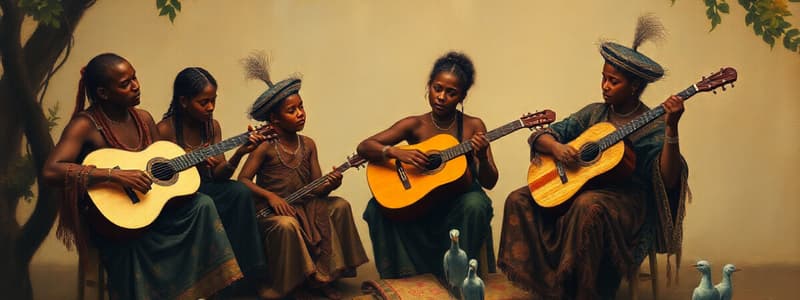Podcast
Questions and Answers
Which of the following descriptions accurately represents the Katajjaq performance?
Which of the following descriptions accurately represents the Katajjaq performance?
- A duet between two women involving rhythmic stomping and chanting.
- A group performance where singers imitate the sounds of nature
- A solo performance involving intricate throat singing techniques.
- A duet between two women, focused on vocal endurance and performed face-to-face. (correct)
The bull-roarer, used by Australian First Nations peoples, primarily served what purpose?
The bull-roarer, used by Australian First Nations peoples, primarily served what purpose?
- Long-distance communication (correct)
- Attracting animals during hunts
- Accompanying ceremonial dances
- Storytelling and oral traditions
What distinguishes Sean-nós from other forms of traditional Irish music?
What distinguishes Sean-nós from other forms of traditional Irish music?
- Its complex rhythmic structure and use of percussion instruments.
- Its focus on storytelling through ballads accompanied by a harp.
- Its unaccompanied nature and embellishment with grace notes, often sung in Gaelic. (correct)
- Its use of the Gaelic language combined with intricate fiddle playing.
What is a key element of the Montana Grass Dance performance?
What is a key element of the Montana Grass Dance performance?
Which cultural tradition involves a competitive element as part of its performance?
Which cultural tradition involves a competitive element as part of its performance?
How is the bull-roarer distinct from the other instruments and traditions described?
How is the bull-roarer distinct from the other instruments and traditions described?
Which of the traditions is most characterized by its unaccompanied vocal performance?
Which of the traditions is most characterized by its unaccompanied vocal performance?
Flashcards
Katajjaq
Katajjaq
Inuit throat singing performed by two women duetting face-to-face.
Bull-roarer
Bull-roarer
Australian instrument used to communicate over long distances, shaped like a raven.
Sean-nós
Sean-nós
Traditional unaccompanied Irish songs often sung in Gaelic, embellished with grace notes.
Montana Grass Dance
Montana Grass Dance
Signup and view all the flashcards
Throat singing
Throat singing
Signup and view all the flashcards
First Nations
First Nations
Signup and view all the flashcards
Grace notes
Grace notes
Signup and view all the flashcards
Study Notes
Inuit Throat Singing
- Katajjaq is a form of throat singing performed by Inuit women
- It's a form of entertainment
- It's typically performed by two women
- They stand face-to-face and compete to see who can sing the longest
Irish Traditional Music
- Sean-nós is an unaccompanied Irish musical style
- It features embellished grace notes
- It's sung in the Gaelic language
Australian Aboriginal Musical Instrument
- Bull-roarers are musical instruments used by Aboriginal Australians
- They were used to communicate over long distances
- They create a roaring sound when swung around
Navajo Ceremonial Dance
- The Montana grass dance is a Navajo ceremonial dance performed in North America
- Dancers wear flowing ceremonial dresses
- They sing dramatically, tensing their vocal chords
Irish Stone Carvings
- Gaelic inscriptions are found on pillars in Ireland
Studying That Suits You
Use AI to generate personalized quizzes and flashcards to suit your learning preferences.




